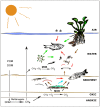Methane carbon supports aquatic food webs to the fish level
- PMID: 22880091
- PMCID: PMC3413669
- DOI: 10.1371/journal.pone.0042723
Methane carbon supports aquatic food webs to the fish level
Erratum in
- PLoS One. 2013;8 (1). doi:10.1371/annotation/a1ff8f9e-ebdc-479d-96d3-d01ecdf26b9e
Abstract
Large amounts of the greenhouse gas methane (CH(4)) are produced by anaerobic mineralization of organic matter in lakes. In spite of extensive freshwater CH(4) emissions, most of the CH(4) is typically oxidized by methane oxidizing bacteria (MOB) before it can reach the lake surface and be emitted to the atmosphere. In turn, it has been shown that the CH(4)-derived biomass of MOB can provide the energy and carbon for zooplankton and macroinvertebrates. In this study, we demonstrate the presence of specific fatty acids synthesized by MOB in fish tissues having low carbon stable isotope ratios. Fish species, zooplankton, macroinvertebrates and the water hyacinth Eichhornia crassipes were collected from a shallow lake in Brazil and analyzed for fatty acids (FA) and carbon stable isotope ratios (δ(13)C). The fatty acids 16:1ω8c, 16:1ω8t, 16:1ω6c, 16:1ω5t, 18:1ω8c and 18:1ω8t were used as signature for MOB. The δ(13)C ratios varied from -27.7‰ to -42.0‰ and the contribution of MOB FA ranged from 0.05% to 0.84% of total FA. Organisms with higher total content of MOB FAs presented lower δ(13)C values (i.e. they were more depleted in (13)C), while organisms with lower content of MOB signature FAs showed higher δ(13)C values. An UPGMA cluster analysis was carried out to distinguish grouping of organisms in relation to their MOB FA contents. This combination of stable isotope and fatty acid tracers provides new evidence that assimilation of methane-derived carbon can be an important carbon source for the whole aquatic food web, up to the fish level.
Conflict of interest statement
Figures



References
-
- Sohngen NL (1906) Über Bakterien, welche Methan als Kohlenstoffnahrung und Energiequelle gebrauchen. Centralbl Bakteriol Parasitenk Infektionskr Abt I 15: 513–517.
-
- King GM (1992) Ecological aspects of methane oxidation, a key determinant of global methane dynamics. Adv Microbial Ecol 12: 431–468.
-
- Boetius A, Ravenschlag K, Schubert CJ, Rickert D, Widdel F, et al. (2000) A marine microbial consortium apparently mediating anaerobic oxidation of methane. Nature 407: 623–626. - PubMed
-
- Op den Camp HJM, Islam T, Stott MB, Harhangi HR, Hynes A, et al. (2009) Environmental, genomic and taxonomic perspectives on methanotrophic Verrucomicrobia. Environ Microbiol Rep 1: 293–306. - PubMed
-
- Bodelier PLE, Gillisen MJB, Hordijk K, Damsté JSS, Rijpstra WIC, et al. (2009) A reanalysis of phospholipid fatty acids as ecological biomarkers for methanotrophic bacteria. ISME J 3: 606–617. - PubMed
Publication types
MeSH terms
Substances
LinkOut - more resources
Full Text Sources
Research Materials
Miscellaneous

